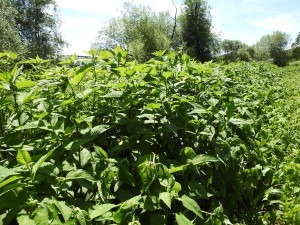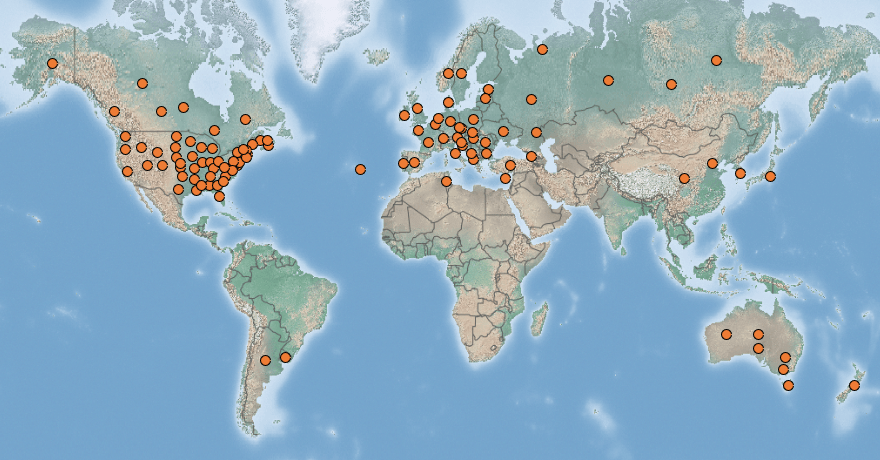 |
Jerusalem artichoke | Status LU: established. 1st record: LU ~1720, ITW <1875. |
 |
Topinambur, Russesch Gromper1 | Status Eur.: established. 1st record: UK 1607. |
 |
Topinambour | RA: ISEIA: B2, Watch List. Harmonia+: 0,47. |
 |
Topinambur | Wikipedia:     | Wikispecies: | Wikispecies:  | CABI | CABI |
 |
Aardpeer | Back to the list of neophytes |
Contents
Report the species
→ Report Helianthus tuberosus to the National Museum of Natural History.
Brief description
Helianthus tuberosus L. is a plant that prefers well-lit, sandy, moist and nutrient-rich soils. It grows best in habitats repeatedly disturbed by floods (riparian areas) but may also occur in ruderal and agricultural environments. In western European climatic conditions, the plant does not produce viable seeds and propagates vegetatively. Tubers and pieces of rhizomes are transported with rodents and flowing water, especially winter floods. The plant can produce dense and persistent monospecific populations along rivers, where it outcompetes native species, slows down natural colonisation by trees and favours river bank erosion. It can be a weed of agricultural fields either by invading the fields or by reducing the yield of consecutive crops.
Introduction in Luxembourg
The Jerusalem artichoke arrived in Luxembourg at the beginning of the 18th century. In his seminal work “La pomme de terre en Wallonie au XVIIIe siècle” (1976), the Belgian historian Fernand Pirotte draws the following conclusions (Pirotte 1976 cit. in Massard 2009):
- at the beginning of the 18th century, a first previously unknown tuber plant, the Jerusalem artichoke, probably originating from Lorraine, was introduced into the Duchy of Luxembourg under its name “pomme de terre” (earth apple), which was commonly used in Lorraine.
- around 1715-1720, another tuber plant, the potato, the ‘poire de terre’ or ‘Grundbirne’, was imported from the Rhineland (later the Rhine province) and was called ‘crompire’ or ‘grompir’ by the people.
- the two species coexisted for some time, with a rapidly increasing dominance of the potato, which overtook Jerusalem artichoke within 20 to 25 years, before 1740. In the 1750s, or at the beginning of the 1760s at the latest, the potato has definitely replaced the Jerusalem artichoke. Paradoxically, the authorities retained the designation “topinambour”, but from about 1740/50 onward they used it for the potato, which they had virtually ignored until then, since its cultivation had been limited to gardens and had thus remained tithe-free.
Status and distribution in Luxembourg
Records of Helianthus tuberosus L. in Luxembourg. Data source: Recorder-Lux, iNaturalist & GBIF, 2025-07-02.
“It seems that the introduction of this tuber, also originating from the New World, dates from the same period as the potato [~1725], and that by the middle of the last century [1750] its cultivation was proportionally more widespread than today” (Fischer 1860: 143; 1872: 77-78). But there may be a confusion of names, as potato cultivation was introduced in the 1720s under the name of topinambour or “ground pear” (De la Fontaine cit. in Fischer 1860: 143).2
In 1741 the tithe (tax) was already raised on the Jerusalem artichoke (Ozeray 1827: 267).
In the middle of the 19th century, “Jerusalem artichokes[…] are so little cultivated in the Grand Duchy that the vast majority of farmers do not yet know its tubers. It is even regrettable that the resources that Jerusalem artichokes can offer in certain circumstances have not yet been fully appreciated” (Fischer 1860: 143).3
Helianthus tuberosus was locally cultivated in Luxembourg throughout the 19th century (Löhr 1844: 126, Fischer 1872: 77), especially around Greisch and Ansembourg castle (Tinant 1836: 434). Krombach (1875: 331) states it is sometimes grown in sandy soils and then occurs also subspontaneously.
The first documented observation of the species in Luxembourg dates from 1880. On 21st October 1880, the Société de botanique collected a specimen from a garden in Dommeldange, north of Luxembourg City (Specimen nr. LUX003675, MNHNL 2000-). The first documented observation of the species in the wild dates from 1956. It was found by Léopold Reichling on 30th September 1956 in Born in the municipality of Mompach (MNHNL 2000-). There are 427 observations in the Recorder-Lux database (MNHNL, iNaturalist & GBIF 2019).
According to Lambinon & Verloove (2012: 720), it grows in banks, gravel and mud banks along watercourses, often in large stands, is naturalised in the Lorraine district (rivers Chiers, Moselle and tributaries (AR), but locally very abundant; elsewhere rare (R), subspontaneous or locally naturalised. Rarely cultivated in gardens, especially in the past, for its edible but generally not very appreciated tubers, nowadays sometimes in fallows, for feeding game.
The Jerusalem artichoke is widely distributed along the Lower Alzette, the Lower Sûre and the Moselle. Along the Alzette, important populations of the species often appear at the edge of corn fields.
Risk assessment
ISEIA protocol
B2 (2+3+2+2) = Watch List (Ries et al. 2013: 18).
Harmonia+ protocol
Overall risk score 0,47 = (Overall Invasion score 0,88 x Overall Impact score 0,53) (Ries et al. 2020).
 Invasion
Invasion0,53

 Impact
Impact0,47

 Risk
RiskWorldwide distribution
Bibliography
- CABI, 2019. Helianthus tuberosus. In: Invasive Species Compendium. Wallingford, UK: CAB International. URL: www.cabi.org/isc [accessed 2020-03-02]
- Fischer, E., 1860. Notices historiques sur la situation agricole du grand-duché de Luxembourg. 2e édition, 254 p. Luxembourg : imprimerie Buck.
- Fischer, E., 1872. Les plantes subspontanées et naturalisées de la flore du grand-duché de Luxembourg. Publications de l’Institut royal grand-ducal de Luxembourg, section des sciences naturelles et mathématiques XII: 1-115. Imprimerie V. Buck, Luxembourg.
- Krippel, Y. & G. Colling, 2006. Notes floristiques. Observations faites au Luxembourg (2004-2005). Bull. Soc. Nat. luxemb. 107: 89-103. [PDF 288 Kb]
- Krombach, J.-H.-G., 1875. Flore du grand-duché de Luxembourg. Plantes phanérogames. 564 p. Luxembourg, Imprimerie Joris.
- Lambinon J. & F. Verloove, 2012. Nouvelle flore de la Belgique, du grand-duché de Luxembourg, du Nord de la France et des régions voisines. Sixième édition. Avec la collaboration de L. Delvosalle, B. Toussaint, D. Geerinck, I. Hoste, F. Van Rossum, B. Cornier, R. Schumacker, A. Vanderpoorten et H. Vannerom. Jardin botanique national de Belgique, Meise. CXXXIX + 1195 pp. ISBN : 9789072619884.
- Löhr, M. J., 1844. Taschenbuch der Flora von Trier und Luxemburg : mit Berücksichtigung der Nahe- und Glan-Gegenden. 319 S. Trier, Verlag C. Troschel.
- Massard, J. A., 2009. 300 Jahre Kartoffel in Luxemburg: (I) Europa entdeckt die Kartoffel. (II) Grundbirne, Grompir, Gromper: die Kartoffel erobert Luxemburg. (III) Die Kartoffel in Luxemburg im 19. Jh. Artikel aus: Lëtzebuerger Journal 2009, [I] Nr. 15 (22. Jan.): 23; Nr.16 (23. Jan.): 10, Nr. 17 (24./25. Jan.): 11; [II] Nr. 18 (27. Jan.): 23, Nr. 19 (28. Jan.): 21; [III] Nr. 20 (29. Jan.): 9, Nr. 21 (30. Jan.): 21.
- MNHNL, 2000-. Helianthus tuberosus L. in Recorder-Lux, database on the natural heritage of the Grand Duchy of Luxembourg. Musée national d’histoire naturelle, Luxembourg. URL: https://mdata.mnhn.lu [Accessed 2019-09-05]
- MNHNL, iNaturalist & GBIF, 2019. Helianthus tuberosus L. in MNHNL-mdata, online portal combining species observation from Recorder-Lux, iNaturalist and GBIF. National Museum of Natural History, Luxembourg. URL: https://mdata.mnhn.lu [Accessed 2019-09-05]
- Ozeray, M.-J.-F., 1827. Histoire des pays, château et ville de Bouillon depuis l’origine du Duché jusqu’à la révolution de 1789. 348 p. Imprimerie J. Lamort, Luxembourg. (1re édition) [online source]
- Pfeiffenschneider, M., P. Gräser & C. Ries, 2014. Distribution of selected neophytes along the main rivers of Luxembourg. Bull. Soc. Nat. luxemb. 115: 101-108. [PDF 3668 KB]
- Pirotte, F., 1976. La pomme de terre en Wallonie au XVIIIe siècle. Liège, Editions du Musée wallon, 87 p. (= Collection d’études publiée par le Musée de la vie wallonne, 4).
- Ries, C. & Y. Krippel, 2021. First records of 56 invasive alien vascular plants in Luxembourg. Bulletin de la Société des naturalistes luxembourgeois 123: 115-127. [PDF 241 KB]
- Ries, C., Y. Krippel, M. Pfeiffenschneider & S. Schneider, 2013. Environmental impact assessment and black, watch and alert list classification after the ISEIA Protocol of non-native vascular plant species in Luxembourg. Bull. Soc. Nat. luxemb. 114: 15-21. [PDF 652 KB]
- Ries, C., Y. Krippel & M. Pfeiffenschneider, 2020. Risk assessment after the Harmonia+ protocol of invasive alien vascular plant species in Luxembourg. Bull. Soc. Nat. luxemb. 122: 197-205. [PDF 132 KB]
- Tinant, F. A., 1836. Flore luxembourgeoise, ou, Description des plantes phanérogames, recueillies et observées dans le grand-duché de Luxembourg, classées d’après le système sexuel de Linnée. 512 p. Luxembourg, J. P. Kuborn.
Suggested citation of this webpage
Ries, C., M. Pfeiffenschneider & Y. Krippel (Eds.), 2025. Helianthus tuberosus L. In: neobiota.lu - Invasive Alien Species in Luxembourg. National Museum of Natural History, Luxembourg. URL: https://neobiota.lu/helianthus-tuberosus/ [Accessed 2025-07-02].
Page content last updated on 2021-03-04. Last proofread by Caroline Grounds on 2019-11-18.
- Cf. Krombach 1875: 331.[↩]
- Original text: « Il faut croire que l’introduction de ce tubercule, aussi originaire du nouveau monde, date de la même époque que la pomme de terre, et que vers le milieu du siècle dernier la culture en était proportionnellement plus répandue qu’aujourd’hui. » (Fischer 1860: 143) Mais il se peut qu’il y ait une confusion de noms, la culture de la pomme de terre ayant été introduite dans les années 1720 sous le nom de topinambour ou poire de terre (De la Fontaine cit. in Fischer 1860: 143).[↩]
- Original text: « Les topinambours […] sont si peu cultivés dans le Grand-Duché, que l’immense majorité des laboureurs n’y connaissent pas encore ses racines. Il est même à regretter qu’on n’ait pas jusqu’ici apprécié à leur juste valeur les ressources que le topinambour peut offrir dans certaines circonstances » (Fischer 1860: 143).[↩]



